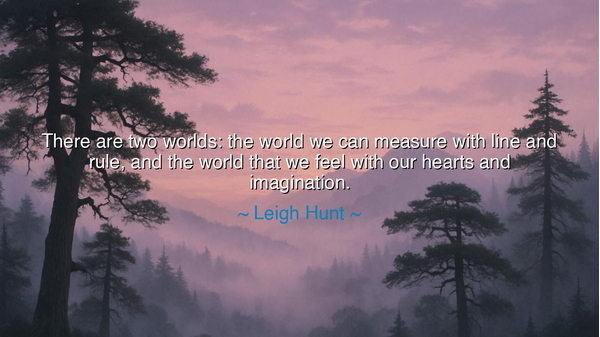
There are two worlds: the world we can measure with line and
There are two worlds: the world we can measure with line and rule, and the world that we feel with our hearts and imagination.






In the luminous words of Leigh Hunt, poet of tenderness and friend to the dreamers of his age, there is a truth that stands eternal: “There are two worlds: the world we can measure with line and rule, and the world that we feel with our hearts and imagination.” These words, gentle yet profound, remind us that reality is not made of numbers alone — that behind the visible lies the invisible, and beyond the measured lies the immeasurable. Hunt, who lived in an age of reason and revolution, saw that man was in danger of forgetting one half of himself: the half that dreams, that feels, that imagines. His voice, then, is the voice of balance — calling to us across centuries to remember that life is not complete without both the world of fact and the world of feeling.
The origin of this insight lies in the Romantic spirit of Hunt’s time — an era when poets and thinkers rose against the cold dominance of reason. The world had become obsessed with progress, invention, and measurement. Science and industry promised to master nature, to weigh and define all things by line and rule. Yet amid this age of calculation, Hunt and his companions — Wordsworth, Shelley, Keats — reminded mankind that not everything that counts can be counted. There exists another world, they said, one born of heart and imagination, where beauty, love, and wonder dwell. To lose that world is to lose the very soul of existence. Hunt’s quote stands as a defense of that sacred realm — the inner world that no instrument can chart and no law can bind.
The world we can measure is the realm of science, logic, and form — a world of boundaries, equations, and certainty. It gives us bridges, medicines, and tools; it allows us to conquer the material. Yet it is also the world that can imprison the spirit when worshiped alone. For what is the worth of knowledge if it does not awaken wonder? What is the use of progress if it does not deepen compassion? Hunt warns that when man lives only by the line and rule, he becomes a craftsman of mechanism but a stranger to mystery. The heart and imagination give meaning to what the mind can explain; they breathe life into the facts, turning existence into experience, and measurement into meaning.
Consider the story of Isaac Newton, whose discovery of gravity forever changed the way we understand the cosmos. His genius was not only in the mathematics he wrote, but in the imagination that first saw the apple fall and asked why. His mind moved between both worlds — he measured the stars with reason, but he dreamed of their harmony with wonder. And later, when Albert Einstein expanded Newton’s laws, it was his imagination, not his instruments, that first leapt beyond the visible. He envisioned himself riding on a beam of light — a dream that no ruler could measure, yet one that reshaped the laws of the universe. These men lived, as Hunt described, between the world of line and rule and the world of heart and imagination — and because they united them, civilization moved forward in both knowledge and spirit.
The same is true in art, in faith, and in love. The heart perceives truths that no calculation can prove. A mother does not measure the worth of her child by height or weight; she knows it in her soul. A poet cannot define beauty by formula, yet he can make the world weep with a single image. A lover cannot describe love in numbers, yet it drives nations and shapes destinies. These are the truths of the second world — the one that lives in feeling and imagination. It is this realm that gives warmth to knowledge, purpose to labor, and immortality to the human story. Without it, man becomes clever but not wise, skilled but not kind, prosperous but not fulfilled.
Hunt’s teaching, then, is a call to unity — to balance the worlds within us. He does not reject reason or knowledge, for they are the instruments through which we understand creation. But he insists that imagination must guide them, and the heart must temper them. A society that builds machines but forgets music will crumble; a mind that masters the stars but forgets compassion will lose its way in the darkness. It is only when science and spirit, reason and imagination, walk hand in hand that humanity thrives.
So, my child, take this teaching into your life: live in both worlds. Learn the world of line and rule — study, observe, and understand. But do not become its prisoner. Make room in your soul for the world of heart and imagination, where wonder lives and beauty speaks. When you see a flower, do not only count its petals — feel its fragrance, its silence, its song. When you speak, do not only choose your words wisely — let them be touched with feeling. When you labor, do not only seek results — seek meaning. For it is in this balance, between the measurable and the immeasurable, that life becomes whole.
And remember always the wisdom of Leigh Hunt: that man is not a creature of numbers alone. The world you can measure will one day fade — but the world you can imagine will endure forever. The heart, once awakened, outlives all empires of logic. Guard it well, nurture it daily, and let your imagination lift the weight of the world until even the smallest thing shines with the infinite.






AAdministratorAdministrator
Welcome, honored guests. Please leave a comment, we will respond soon